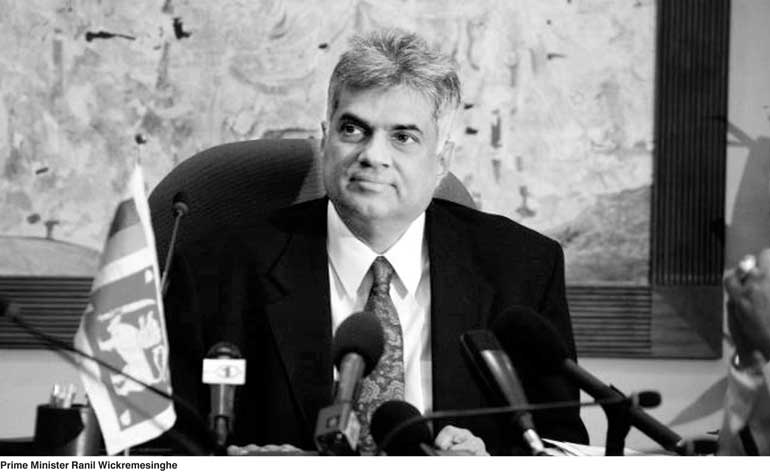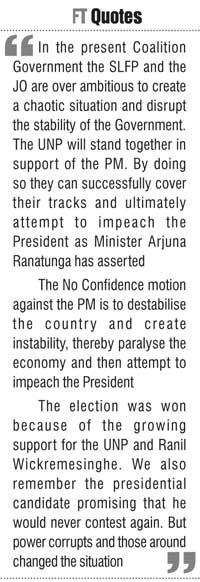Friday Mar 14, 2025
Friday Mar 14, 2025
Saturday, 24 March 2018 00:00 - - {{hitsCtrl.values.hits}}

Ranil Wickremesinghe, the most popular Prime Minister, has made fellow politicians nervous if he is allowed to continue.
Famous Indian Prime Ministers have faced the crisis when they became popular and a risk to fellow politicians. Lal Bahadur Shastri and Narasimha Rao (thrice each), Morarji Desai (twice) and Jawahar Lal Nehru, Rajiv Gandhi and Atal Bihari Vajpayee (once each). All the no-confidence motions have been defeated except once when Prime Minister Morarji Desai resigned during the discussions on 12 July 1979.
No Confidence
A motion of no confidence is a statement or vote which states that a person in a position of responsibility is no longer deemed fit to hold that position, perhaps because they are inadequate in some respect, are failing to carry out obligations, or are making decisions that other members feel are detrimental. As a parliamentary motion, it demonstrates to the head of state that the elected parliament no longer has confidence in the appointed government.
Coalition Government
In the present Coalition Government the SLFP and the JO are over ambitious to create a chaotic situation and disrupt the stability of the Government. The UNP will stand together in support of the PM. By doing so they can successfully cover their tracks and ultimately attempt to impeach the President as Minister Arjuna Ranatunga has asserted.
 No confidence against PM
No confidence against PM
The No Confidence motion against the PM is to destabilise the country and create instability, thereby paralyse the economy and then attempt to impeach the President.
2015 and the aftermath
Prior to the presidential election we saw how desperate the architect of the change was, CBK, who chose Maithripala Sirisena and made him wear the Indian garb to give a new look, a ‘change’ in the name of ‘Yahapalanaya”. But the election was won because of the growing support for the UNP and Ranil Wickremesinghe. We also remember the presidential candidate promising that he would never contest again. But power corrupts and those around changed the situation.
19th Amendment
The 19th Amendment to the Constitution was enacted because of CBK’s well-known moves to dissolve Parliament in the past as and when she wanted to disrupt the Government of Ranil Wickremesinghe. Ranil Wickremesinghe known as Mr. Clean still remains clean but vested interests have maligned and created a situation to undermine a man of integrity so that he is out of the way. Will they succeed? Should they be allowed to succeed?
What the President must realise is that his position is secure until Ranil Wickremesinghe remains PM. If the PM is removed, then it follows that the President be removed for the JO to get together with the SLFP to oust the President.
Variations
In some countries a motion of no confidence can be directed at the government collectively or at any individual member, including the prime minister. In Spain it is presented by the prime minister after consultation. Sometimes motions of no confidence are proposed even though they have no likelihood of passage, simply to pressure a government or to embarrass its own critics, who may for political reasons decide not to vote against it.
Parliamentary systems
In many parliamentary democracies, strict time limits exist as to the proposal of a no confidence motion, with a vote only allowed once every three, four or six months. Thus the timing of a motion of no confidence is a matter of political judgement; using a motion of no confidence on a relatively trivial matter may prove counterproductive if a more important issue suddenly arises which warrants a motion of no confidence, because a motion cannot be proposed if one had been voted on recently. Sometimes, the government will choose to declare that one of its bills is a “motion of confidence” in order to prevent dissident members of parliament from voting against it.
United Kingdom
Traditionally, in the Westminster system, the defeat of a supply bill (one that concerns the spending of money) is seen to automatically require the government to either resign or ask for a new election, much like a non-confidence vote. A government in a Westminster system that cannot spend money is hamstrung, also called loss of supply. When the upper house of a Westminster system country has the right to refuse supply, such as in Australia during the events of 1975, the convention is in a grey area, as Westminster governments are not normally expected to maintain the confidence of the upper house.
Prior to 2011, in the British Parliament, a no-confidence motion generally first appeared as an early day motion, although the vote on the Queen’s Speech also constituted a confidence motion. However, under the Fixed-term Parliaments Act 2011, only a motion explicitly resolving “That this House has no confidence in Her Majesty’s Government” is treated as a motion of no confidence.
The first motion of no confidence occurred in March 1782 when, following news of the British defeat at Yorktown in the American Revolutionary War the previous October, the Parliament of Great Britain voted that they “can no longer repose confidence in the present ministers”. Prime Minister Lord North responded by asking King George III to accept his resignation. This did not immediately create a constitutional convention. During the early 19th century, however, attempts by prime ministers such as Robert Peel to govern in the absence of a parliamentary majority proved unsuccessful, and by the mid-19th century, the power of a motion of no confidence to break a government was firmly established in the UK.
In the United Kingdom, 11 prime ministers have been defeated through a no-confidence motion. There has been only one (against James Callaghan) since 1925.
In modern times, passage of a motion of no confidence is a relatively rare event in two-party democracies. In almost all cases, party discipline is sufficient to allow a majority party to defeat a motion of no confidence, and if faced with possible defections in the government party, the government is likely to change its policies rather than lose a vote of no confidence. The cases in which a motion of no confidence has passed are generally those in which the government party’s slim majority has been eliminated by either by-elections or defections, such as the 1979 vote of no confidence in the Callaghan ministry in the UK which was carried by one vote, forcing a general election which was won by Margaret Thatcher’s Conservative Party.
India
In India, a motion of No Confidence can be introduced only in the Lok Sabha (the lower house of the Parliament of India). The motion is admitted for discussion when a minimum of 50 members of the house support the motion. If the motion carries, the House debates and votes on the motion. If a majority of the members of the house vote in favour of the motion, the motion is passed and the Government is bound to vacate the office.
Acharya Kripalani moved the first-ever No confidence motion on the floor of the Lok Sabha in August 1963, immediately after the disastrous India-China War.As of July 2008, 26 no-confidence motions have been moved. Prime Minister Indira Gandhi faced the most number of no-confidence motions - 15 times, followed by Lal Bahadur Shastri and Narasimha Rao (thrice each), Morarji Desai (twice) and Jawahar Lal Nehru, Rajiv Gandhi and Atal Bihari Vajpayee (once each). All the no-confidence motions have been defeated except once when Prime Minister Morarji Desai resigned during the discussions on 12 July 1979.
With the anti-defection law, vote of no confidence has no relevance left in case the majority party has an absolute majority in the House. If the majority party (with an absolute majority in the House) issues whip to vote party members in favour of the Government, then it is impossible to remove the Government by no-confidence motion. Hence the no-confidence exercise of the House merely becomes the no-confidence exercise of the party.
Italy
In Italy, the government requires the support of both houses of the Parliament. A vote of no confidence may be proposed if one tenth of the members of a single house sign the proposition and starting from three days before the appointed date, said vote can be brought into discussion. Following the case of Filippo Mancuso in 1995 and the subsequent Constitutional Court sentence in 1996, it is possible to propose an individual vote of no confidence against a single minister instead of the whole government.
Germany
In Germany, a vote of no confidence in the Federal Chancellor requires that the opposition, on the same ballot, propose a candidate of their own whom they want to be appointed as successor by the Federal President. Thus, a motion of no confidence can only be brought forward if there is a positive majority for the new candidate (this variation is called a constructive vote of no confidence). The idea was to prevent crises of the state such as those found near the end of the German Weimar Republic.
Frequently, Chancellors were turned out of office without their successors having enough parliamentary support to govern. Unlike the British system, the Chancellor does not have to resign in response to the failure of a vote of confidence, provided it has been initiated by them and not by the parliamentary opposition, but rather may ask the President to call general elections – a request the President may or may not fulfil.
Japan
Article 69 of the 1947 Constitution of Japan provides that “if the House of Representatives passes a non-confidence resolution, or rejects a confidence resolution, the Cabinet shall resign en masse, unless the House of Representatives is dissolved within ten (10) days.”
Australia
In the Australian Parliament, a motion of no-confidence requires a majority of the members present in the House of Representatives to agree to it. The House of Representatives currently consists of 150 members; requiring 76 votes in favour of the motion when all members of the House are present. A straight vote of no confidence in a Government, or a motion or amendment censuring a Government, has never been successful in the House of Representatives.
Despite this, on eight occasions Governments have either resigned or advised a dissolution following their defeat on other questions before the House. The last time a government resigned after being defeated in the House came in October 1941, when the House rejected the budget of Arthur Fadden’s minority government.
 South Africa
South Africa
On 7 August 2017, Speaker Baleka Mbete announced that she would permit a motion of no confidence in Jacob Zuma’s government to proceed in the National Assembly via secret ballot. It was the eighth motion to be brought against Zuma in his presidency and the first to be held via secret ballot. After the vote was held the next day, the motion was defeated 198-177, with 25 abstentions. Around 20 ANC MPs voted in favour of the measure.
Presidential systems
In presidential systems, the legislature may occasionally pass motions of no confidence and may also have the procedure of impeachment by which an executive or judicial officer can be removed. Motions of no confidence are far more common in multi-party systems in which a minority party must form a coalition government. This can mean that there are many short-lived governments because the party structure allows small parties to defeat a government without means to create a government. This has widely been regarded as the cause of instability for the French Fourth Republic and the German Weimar Republic. More recent examples have been in Italy between the 1950s and 1990s, Israel, and Japan.
To deal with this situation, the French placed a greater degree of executive power in the office of its President, who is immune from motions of no confidence, along with a two-round plurality voting system that makes easier the formation of stable majority governments.
In 2008, Canadian Prime Minister Stephen Harper, of the re-appointed minority government of Canada, requested that Governor-General Michaëlle Jean prorogue Parliament. The request was granted, and it allowed the Prime Minister to delay a potential vote on the non-confidence motion presented by the opposition. (See 2008–2009 Canadian parliamentary dispute). Three years later, in 2011, Harper’s minority government was defeated by a motion of non-confidence declaring the government to be in contempt of Parliament, leading to the election that year.
Motion against PM Wickremesinghe will be defeated
It is trite learning that the No Confidence motion against PM Ranil Wickremesinghe will be defeated. It is unfortunate that he who reigns supreme and was voted into power by the UNP led by Ranil Wickremesinghe has not acted with dignity, integrity and collective responsibility by not halting a rabid controversial private media with vested interests in undermining, ridiculing, insulting and disgracing the Prime Minister of Sri Lanka whilst in office.
(The writer is the author of ‘Economic Diplomacy & Good Governance: Reflections of PM Ranil Wickremesinghe’. ISBN 978-955-51512-5-4 2018 March Publication.)

Discover Kapruka, the leading online shopping platform in Sri Lanka, where you can conveniently send Gifts and Flowers to your loved ones for any event including Valentine ’s Day. Explore a wide range of popular Shopping Categories on Kapruka, including Toys, Groceries, Electronics, Birthday Cakes, Fruits, Chocolates, Flower Bouquets, Clothing, Watches, Lingerie, Gift Sets and Jewellery. Also if you’re interested in selling with Kapruka, Partner Central by Kapruka is the best solution to start with. Moreover, through Kapruka Global Shop, you can also enjoy the convenience of purchasing products from renowned platforms like Amazon and eBay and have them delivered to Sri Lanka.
Discover Kapruka, the leading online shopping platform in Sri Lanka, where you can conveniently send Gifts and Flowers to your loved ones for any event including Valentine ’s Day. Explore a wide range of popular Shopping Categories on Kapruka, including Toys, Groceries, Electronics, Birthday Cakes, Fruits, Chocolates, Flower Bouquets, Clothing, Watches, Lingerie, Gift Sets and Jewellery. Also if you’re interested in selling with Kapruka, Partner Central by Kapruka is the best solution to start with. Moreover, through Kapruka Global Shop, you can also enjoy the convenience of purchasing products from renowned platforms like Amazon and eBay and have them delivered to Sri Lanka.